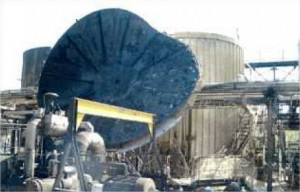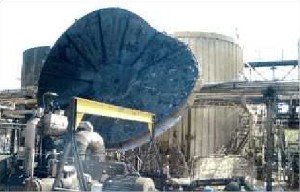At a plant making bitumen, base oils and other by-products, an explosion occurred on a 140-tonne tank containing an additive used in the road bitumen formulation composed of 2 polymers with a high flash point. Heat-insulated and practically full at the time of the accident, the tank had been fitted with a stirrer and reheating coil (for viscous product held above 150°C), as well as a temperature indicator, nitrogen inerting system and a vent. The explosion blew off the tank roof, which landed nearby, and ignited the container.
The internal emergency plan was activated. The plant operator had the fire controlled in 10 min with backup provided by turret nozzles. External fire-fighters were notified yet not required to intervene.
No injuries were reported; property damage was limited to the tank. Wind was blowing towards the dock and away from adjacent dwellings.
Nearly all substances remaining in the tank were transferred into another storage vessel. The quantity of substances lost in the fire was evaluated at 1 m³. The retention basin would be drained.
Upon recommendation of the Inspectorate, the Prefect signed an emergency order suspending supply of the relevant additive for the time allocated to conduct the requisite investigations and appraisals, which revealed that both polymers were capable of decomposing in the presence of heat. The first decomposed into both a substance with a flash point below 50°C and a highly inflammable monomer with a flash point below 0°C. The second substance was capable of releasing extremely inflammable gases. The accident was caused by a slow decomposition of both additive ingredients yielding, in the presence of air, organic peroxides or other substances capable of spontaneous combustion. These ingredients, stored for long periods without stirring, were moreover highly prone to static electricity accumulation. Simple nitrogen sweeping of the tank had created an air intake.
Beyond the immediate measures enacted, the inspectorate proposed the Prefect to act the implementation of the following systems: continuous measurement and automatic regulation of temperature with a high-level alarm, pressure-controlled nitrogen inerting, controls on stirrer motor intensity, and a flap valve vent limiting air or other intake. A study was also requested on extending these devices to the other tanks containing inflammable liquids.
Download the detailed report in .pdf format (75 Kb)





